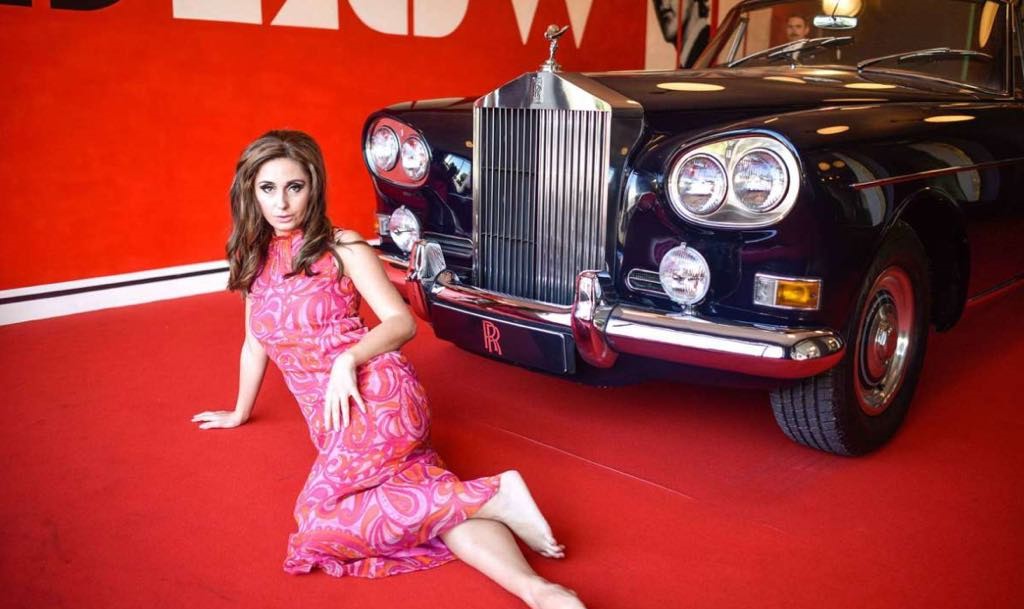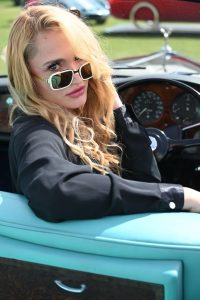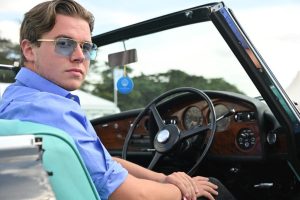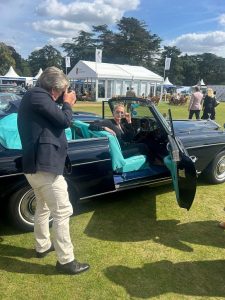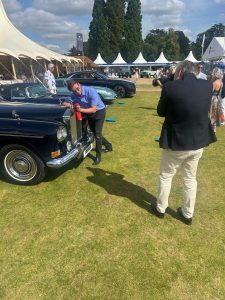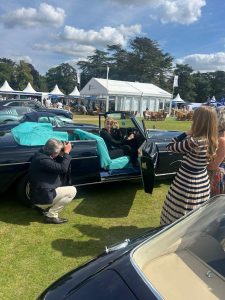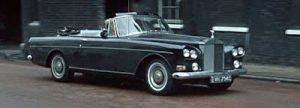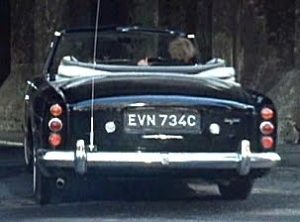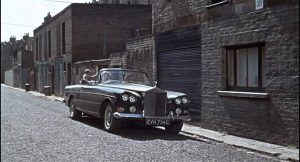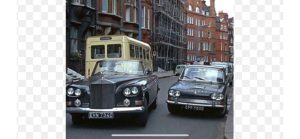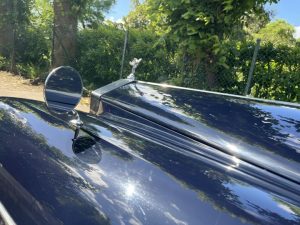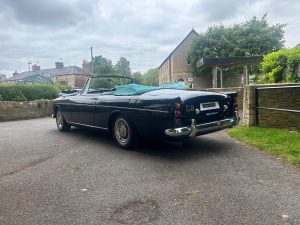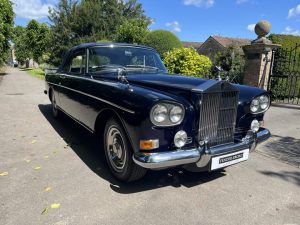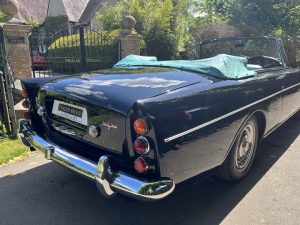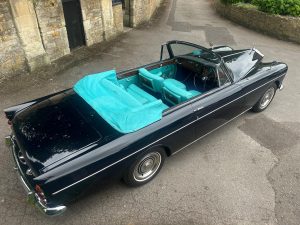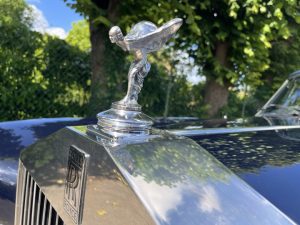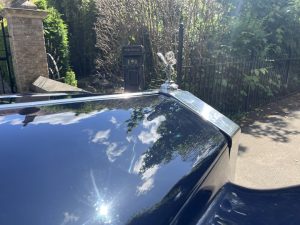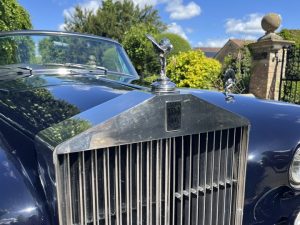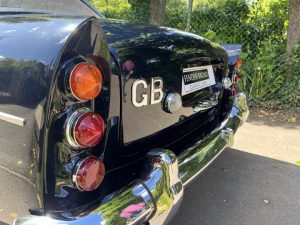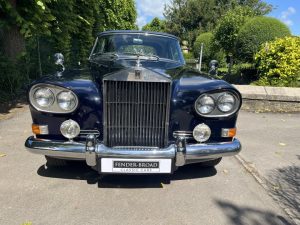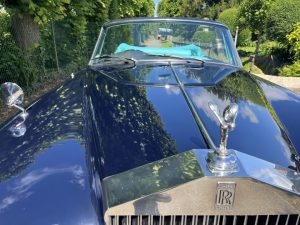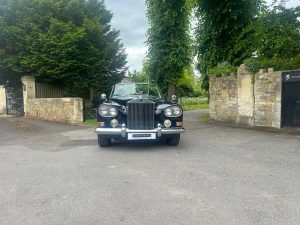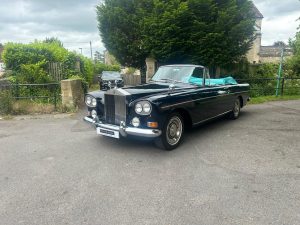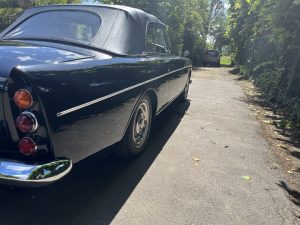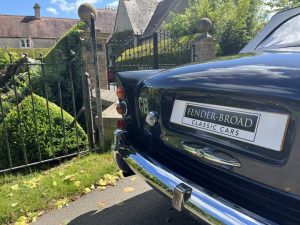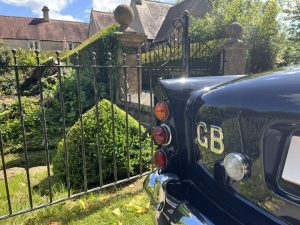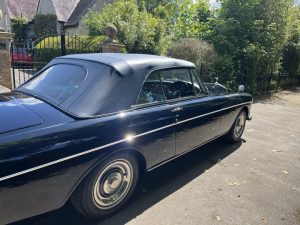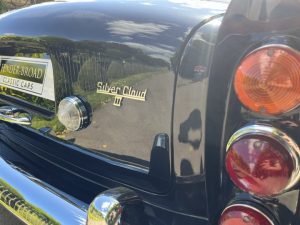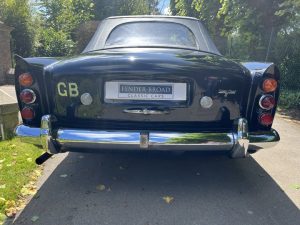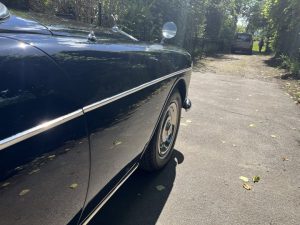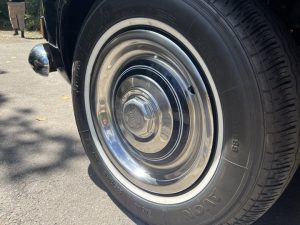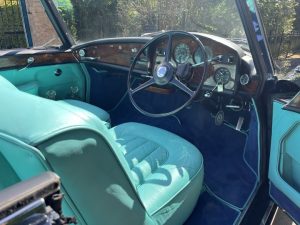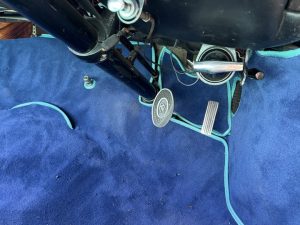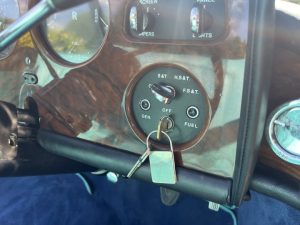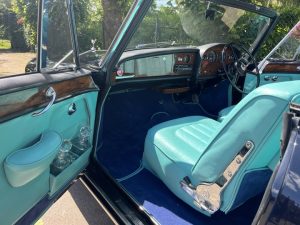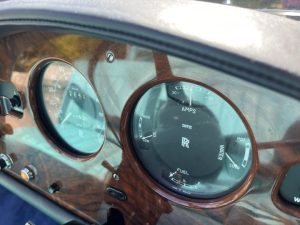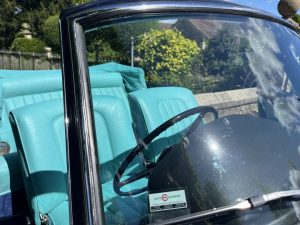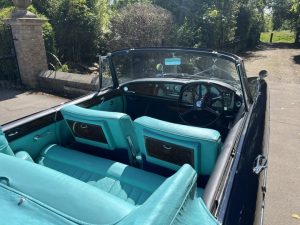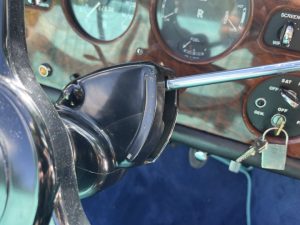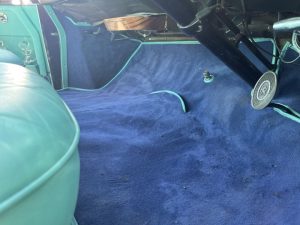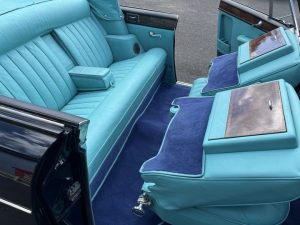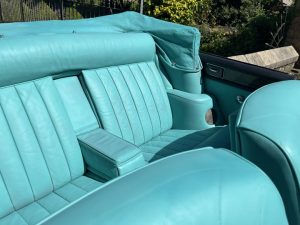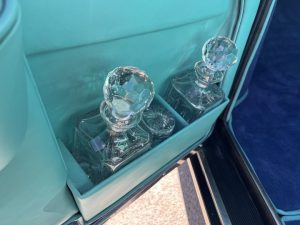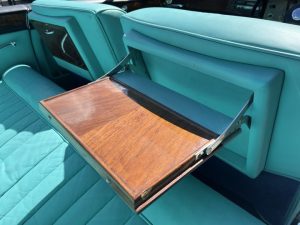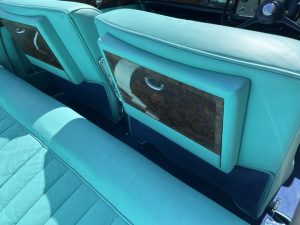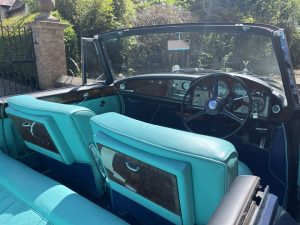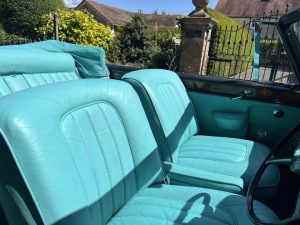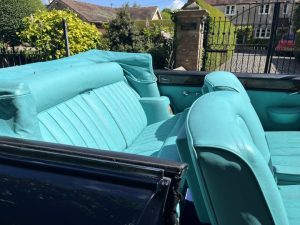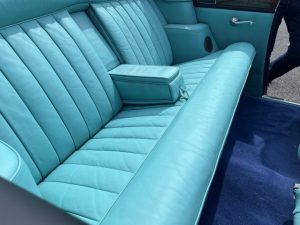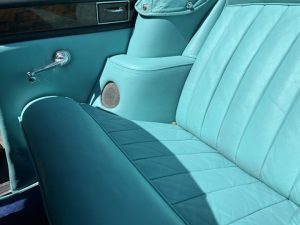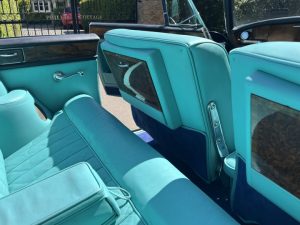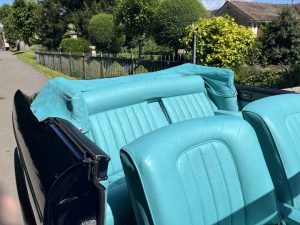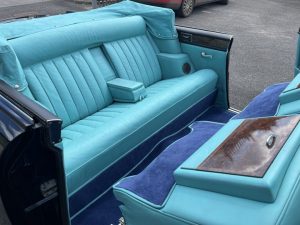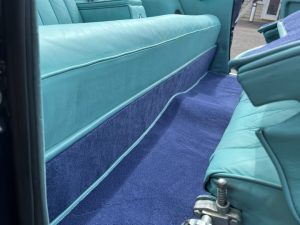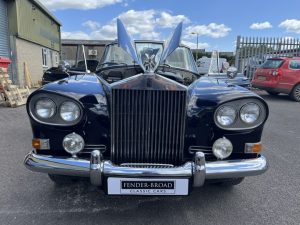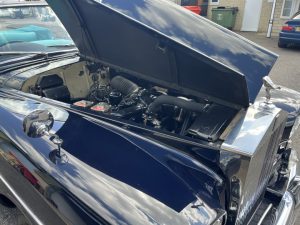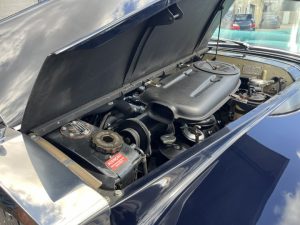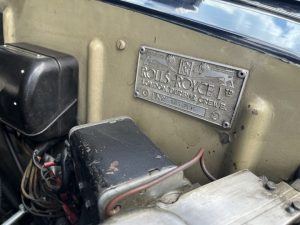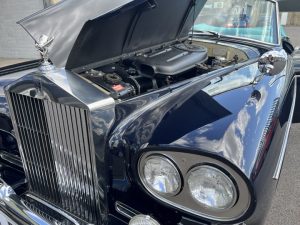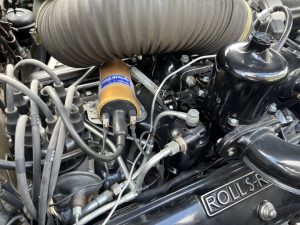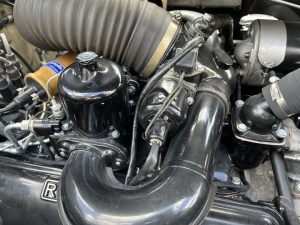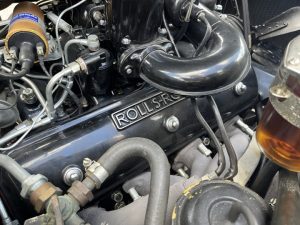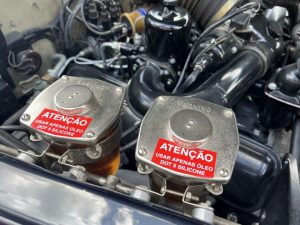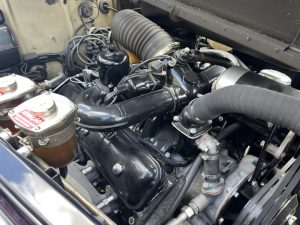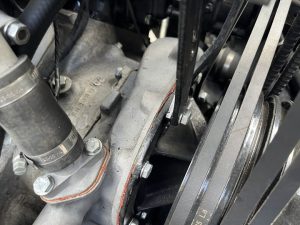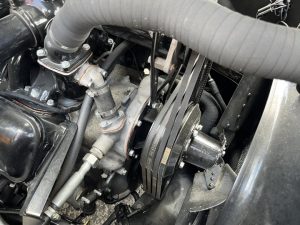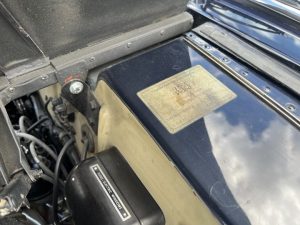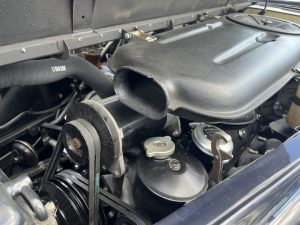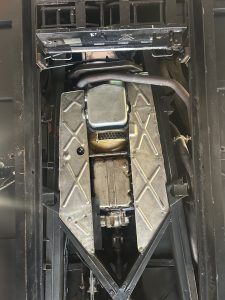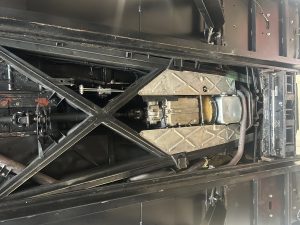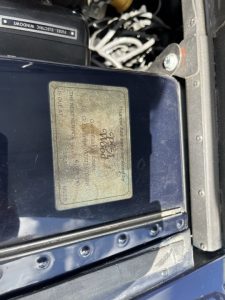Rolls-Royce Silver Cloud III Convertible
Year of Manufacture: 1965
Model: Silver Cloud Convertible III
Exterior Colour: Dark Blue
Interior Colour: Turquoise
Registration: KYY107C
Transmission: Automatic
Year of Manufacture: 1965
Chassis Number: SHS349C
Engine Size: 6 3/4 Litre
Fuel Type: Petrol
£274,995
Description
In 1960’s the sensational Rolls Royce Silver Cloud III convertible was one of the most expensive and desired cars of the swinging 60’s. £4400 was the cost of this ultimate statement of luxury and glamour. £4400 in 1965 would be a shade under £900,000 in today’s money. And yet there were no shortage of suiters wanting one of the most iconic and desirable cars of its generation. Indeed there was a queue of the rich and famous paying premiums prices to gazump their way into the drivers seat of the Cloud III. The revised front light configuration earned the car its ‘chinese eye’ reference and that is the car we are delighted to offer for sale on the button and ready to be driven anywhere with grace and pace.
This is no ‘ordinary’ Cloud III. This is the ex Pierre Rouve car and star of the silver screen swinging sixties cult film classic Blow Up! Cast your mind back
An ageing alarm sounds, and a queue of haggard men in rags trudges towards the exit of a Victorian doss-house underneath a soot-streaked Battersea railway arch. Everything in sight is grey, dull and tatty, reminiscent of the immediate postwar years which still linger in London’s recesses even in the Sixties. One of the men, however, is younger than the others. Handsome despite the dishevelment and dirt. Having bid a couple of other down-and-outs goodbye, he checks that the coast is clear, sneaks around a brick-walled corner – and emerges behind the wheel of a gleaming Rolls-Royce Silver Cloud III drophead. This one, in fact.
It’s one of the most memorable automotive introductions in Sixties cinema. David Hemmings – the actor driving the car – plays Thomas, a photographer inspired by David Bailey and Terence Donovan. A man for whom the voyeuristic appeal of capturing a unique image outweighs everything. The feelings of his subjects, be they vagrants, fashion models or just passers-by, mean nothing to him. Until he finds himself wrestling with his conscience when his snap-happy lens inadvertently captures a murder taking place.
But Blow-Up is so much more than a simple whodunnit. Italian auteur-director Michaelangelo Antonioni provides a mature outsider’s analysis of ‘Swinging London’ that critiques it savagely whilst becoming a part of its iconography itself. So much so that its photography scenes were lampooned in Austin Powers 30 years later as Mike Myers took comedic aim at every Sixties Britflick going.
The car itself was shrouded in mystery for decades too. Not least the question of who its owner was, internet rumour and received opinion pointing in the direction of disgraced DJ Jimmy Savile. While it’s true that Savile’s in the first name on this car’s logbook, he – as per many serial buyers of prestige handbuilt cars in the Sixties – didn’t own it very long. Such was the length of the waiting list for them, they held their value extremely well to the point of owners being able to sell them on for a premium if they put them up for sale immediately.
The car, chassis number SHS349C, was registered EVN 734C to Savile in Scarborough on 23 January 1965, but according to an interview carried out by journalist John Stanley just after 4 March the same year, he no longer owned it, having apparently replaced it with a Phantom V.
So who did own the car? After decades of rumour, this question was finally answered by Hemmings himself, in his posthumously-published 2004 autobiography, and a recollection which puts the Rolls-Royce’s iconic introduction in a different light altogether.
The car had been bought from Savile by the film’s producer, Pierre Rouve, who watched with trepidation as the 25-year-old actor piloted his pride and joy down Queenstown Road in Battersea, only for the filming to be interrupted by a loud bang, clouds of smoke, and several engine parts deposited on the tarmac beneath the car. It was a joke by the props department that Hemmings – ‘nervous as hell’ – had been in on, activating a smoke bomb stuffed with bolts hidden in the engine bay. But neither Rouve – ‘as if paralysed by cardiac arrest’ – nor Antonioni were laughing. ‘You have to learn now, David, this is not a picnic, we are here to work!,’ he ranted. Blow-Up, Hemmings and the British crew realised, would be a world away from the raucous, knockabout, somewhat cheap atmosphere of the Michael Winner films he’d been used to starring in beforehand.
Antonioni’s attention to detail was notorious, to the point where his penchant for manipulating reality to suit his camera passed into legend on Blow-Up. In particular, the parched heat of London in the early summer of 1966 led Antonioni to ask the production crew to repaint the grass, tree trunks and adjacent road surface of Maryon Park in Charlton deeper shades of green and black. In his previous film, Red Desert, Antonioni had repainted the titular dust of Ravenna a deeper shade of red too. This led to myths involving Antonioni repainting other things, such as an entire row of buildings red, and the Rolls-Royce itself black from white. However, in a 2012 interview with Roger Ebert, Antonioni addressed this, admitting to the Maryon Park repainting, but nothing else***. In reality, saturated colour was required for the film stock of the era. The red-painted buildings on Stockwell Road were in fact to highlight their ownership by adjacent motorcycle dealership Pride & Clark, which gained the nickname Snide & Shark due to the exorbitant rents they supposedly charged for them. Savile did own a white Silver Cloud III later on in 1965, but it was registered JS 954 and was likely bought second-hand, leading to the confusion.
It’s also unlikely Rouve would have allowed Antonioni to have repainted his precious Rolls-Royce anyway. A few years earlier, in 1963, Rouve – real name Petar Ouvaliev, Bulgarian diplomat, art critic, broadcaster and theatre director – wanted a Rolls-Royce as a wedding car in his marriage to Sonia Joyce, but didn’t have his own yet. Instead, he contacted a chauffeur friend who ‘borrowed’ one belonging to Richard Burton and Elizabeth Taylor for the morning. Due to routine heavy drinking, neither Burton nor Taylor were usually awake until the afternoon, and were completely unaware it was missing.
Rouve became executive producer on Blow-Up via his friendship with Sophia Loren, wife of the film’s main producer Carlo Ponti, also an avid art collector. Whether it was Rouve, Ponti or Antonioni’s decision to equip the car with an under-dashboard CB radio for the film is unknown, but this was inspired by one that art photographer Terence Donovan had fitted to his brown Rolls-Royce.
After the smoke-bomb incident, Hemmings bodyguarded the car for the rest of the production, recalled by co-star Janet Street-Porter in a 2017 interview with Somerset House. ‘David Hemmings was stuck up as far as we were concerned, not deigning to talk to us. With hindsight, I know he was terrified – this was his first big film part – and I later read that he was sleeping in the Rolls-Royce he drives around in the film,’ she noted.
Rouve kept the car after the film wrapped in October 1966, later passing into private collections and migrating overseas, resulting in its later re-registering with the KYY 107C plate it wears today.
It’s since lost its under-dash CB radio – whether it was only fitted for the filming is unknown, it’s unlikely Rouve would’ve had much use for it – but it still retains its distinctive turquoise leather trim, a note of Sixties youthquake flamboyance juxtaposed against the sober coachwork and Establishment image of the car itself.
In this sense, the car embodies the film’s themes. That sense of stuffy old England up-ended by youthful rule-breakers making huge amounts of money in unconventional ways, splashing out on ostentatious luxury and upsetting the old guard. We see this encapsulated in the antique-shop scene, where the avuncular owner figures Thomas to be a timewaster and claims to be closed. He later returns when a more amenable, younger staff member is on the till, buys an enormous old wooden propellor and – to her consternation – stuffs it into the Rolls-Royce to take it home. Antonioni claimed included the scene solely to make a point about the character, rather than to advance the plot, although it did mean that Thomas – and the Silver Cloud – were adjacent to Maryon Park at that fateful moment when, killing time, he snaps away unsolicited at Vanessa Redgrave with his camera, unaware of the man in the bushes with a silenced pistol…
Our customer bought the car some 15 years ago fresh from a thorough P&A Wood refresh. Since then it has been enjoyed as part of his large collection and domiciled in Porto but still on the DVLA database here in the UK. The car presents in outstanding condition with a faultless mechanical and excellent cosmetic finish.
Just fully serviced, MOT’d and prepared for sale we offer a magnificent piece of British engineering ‘on the button’ without fault and sure to provide the new owner with many outstanding memories that almost go without saying when you are sitting in the magnificent Rolls Royce Silver Cloud III convertible.
It has been my pleasure to drive this extraordinary vehicle some 300miles and each mile has been a joy. This is a huge car and yet it has outstanding main road manners. However, surprisingly it handles really well on back roads and poorly kept roads. Diverted off a motorway I ended up on single track roads and the car was very compliant almost as equally at home. Happier on ‘A’ roads of course but make no mistake this is not a boulevard cruiser. When you want power it has ‘ample’ and when you want to swing around tight bends she will do that for you too. You would think assisted drum brakes might struggle to stop a big car like this. Not so. The car brakes really positively and has no issue with scrubbing speed off. These cars are magnificent pieces of British engineering. Every detail has been considered and the quality of finish and attention is unprecedented. I really ‘get’ why those fortunate enough to be able to order this car would do so back in 1965. Equally, if you are doing well in life and you want something really outstanding to enjoy your classic car hobby then this is a worthy contender. So very rare and a film Icon as covered in the June edition of Classic and Sportscar. Extravagant and yet so absolutely classy. An outstanding and wonderful car.
